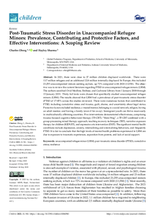Abstract
In 2021, there were close to 37 million children displaced worldwide. There were 13.7 million refugees and an additional 22.8 million internally displaced. In Europe, this included 23,255 unaccompanied minors seeking asylum, up 72% compared with 2020 (13,550).
The objective was to review the current literature regarding PTSD in unaccompanied refugee minors (URM). The authors searched Ovid Medline, Embase, and Cochrane Library from 1 January 2008 through 15 January 2019. Thirty full texts were chosen that specifically studied unaccompanied refugee minors (URM).
The results showed that URM had a prevalence of post-traumatic stress disorder (PTSD of 17–85% across the studies reviewed. There were numerous factors that contributed to PTSD, including cumulative stress and trauma, guilt, shame, and uncertainty about legal status. Protective factors included resilience, a trusted mentor, belonging to a social network, religion, having an adult mentor, and having a family (even if far away). Immigrant youth can thrive most easily in multiculturally affirming countries.
Five interventions demonstrated effectiveness, comprising trauma-focused cognitive behavioral therapy (TF-CBT); “Mein Weg”, a TF-CBT combined with a group-processing mixed therapy approach; teaching recovery techniques (TRT), narrative exposure therapy for children (KIDNET), and expressive arts intervention (EXIT). The significant mental health conditions include depression, anxiety, internalizing and externalizing behaviors, and frequently PTSD.
It is fair to conclude that the high levels of mental health problems experienced in URM are due to exposure to traumatic experiences, separation from parents, and lack of social support.

